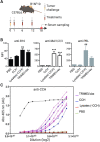A heat-shocked melanoma cell lysate vaccine enhances tumor infiltration by prototypic effector T cells inhibiting tumor growth
- PMID: 32690772
- PMCID: PMC7373330
- DOI: 10.1136/jitc-2020-000999
A heat-shocked melanoma cell lysate vaccine enhances tumor infiltration by prototypic effector T cells inhibiting tumor growth
Abstract
Background: Immune checkpoint blocker (ICB) therapy has shown survival benefits for some patients with cancer. Nevertheless, many individuals remain refractory or acquire resistance to treatment, motivating the exploration of complementary immunotherapies. Accordingly, cancer vaccines offer an attractive alternative. Optimal delivery of multiple tumor-associated antigens combined with potent adjuvants seems to be crucial for vaccine effectiveness.
Methods: Here, a prototype for a generic melanoma vaccine, named TRIMELVax, was tested using B16F10 mouse melanoma model. This vaccine is made of heat shock-treated tumor cell lysates combined with the Concholepas concholepas hemocyanin as adjuvant.
Results: While B16F10 lysate provides appropriate melanoma-associated antigens, both a generic human melanoma cell lysate and hemocyanin adjuvant contributes with danger signals promoting conventional dendritic type 1 cells (cDC1), activation, phagocytosis and effective antigen cross-presentation. TRIMELVax inhibited tumor growth and increased mice survival, inducing cellular and humoral immune responses. Furthermore, this vaccine generated an increased frequency of intratumor cDC1s but not conventional type 2 dendritic cells (cDC2s). Augmented infiltration of CD3+, CD4+ and CD8+ T cells was also observed, compared with anti-programmed cell death protein 1 (PD-1) monotherapy, while TRIMELVax/anti-PD-1 combination generated higher tumor infiltration of CD4+ T cells. Moreover, TRIMELVax promoted an augmented proportion of PD-1lo CD8+ T cells in tumors, a phenotype associated with prototypic effector cells required for tumor growth control, preventing dysfunctional T-cell accumulation.
Conclusions: The therapeutic vaccine TRIMELVax efficiently controls the weakly immunogenic and aggressive B16F10 melanoma tumor growth, prolonging tumor-bearing mice survival even in the absence of ICB. The strong immunogenicity shown by TRIMELVax encourages clinical studies in patients with melanoma.
Keywords: alarmins; immunogenicity, vaccine; immunotherapy, active; melanoma; therapies, investigational.
© Author(s) (or their employer(s)) 2020. Re-use permitted under CC BY. Published by BMJ.
Conflict of interest statement
Competing interests: None declared.
Figures






Similar articles
-
Effective cancer immunotherapy by natural mouse conventional type-1 dendritic cells bearing dead tumor antigen.J Immunother Cancer. 2019 Apr 8;7(1):100. doi: 10.1186/s40425-019-0565-5. J Immunother Cancer. 2019. PMID: 30961656 Free PMC article.
-
Treatment with an immature dendritic cell-targeting vaccine supplemented with IFN-α and an inhibitor of DNA methylation markedly enhances survival in a murine melanoma model.Cancer Immunol Immunother. 2020 Apr;69(4):569-580. doi: 10.1007/s00262-019-02471-0. Epub 2020 Jan 24. Cancer Immunol Immunother. 2020. PMID: 31980915 Free PMC article.
-
Vaccine efficacy against primary and metastatic cancer with in vitro-generated CD103+ conventional dendritic cells.J Immunother Cancer. 2020 Apr;8(1):e000474. doi: 10.1136/jitc-2019-000474. J Immunother Cancer. 2020. PMID: 32273347 Free PMC article.
-
Tumor lysate-based vaccines: on the road to immunotherapy for gallbladder cancer.Cancer Immunol Immunother. 2018 Dec;67(12):1897-1910. doi: 10.1007/s00262-018-2157-5. Epub 2018 Mar 29. Cancer Immunol Immunother. 2018. PMID: 29600445 Free PMC article. Review.
-
Tumor cell lysates as immunogenic sources for cancer vaccine design.Hum Vaccin Immunother. 2014;10(11):3261-9. doi: 10.4161/21645515.2014.982996. Hum Vaccin Immunother. 2014. PMID: 25625929 Free PMC article. Review.
Cited by
-
The role of dendritic cells in tumor microenvironments and their uses as therapeutic targets.BMB Rep. 2021 Jan;54(1):31-43. doi: 10.5483/BMBRep.2021.54.1.224. BMB Rep. 2021. PMID: 33298246 Free PMC article. Review.
-
Enhancing Immunogenicity in Metastatic Melanoma: Adjuvant Therapies to Promote the Anti-Tumor Immune Response.Biomedicines. 2023 Aug 10;11(8):2245. doi: 10.3390/biomedicines11082245. Biomedicines. 2023. PMID: 37626741 Free PMC article. Review.
-
Metformin reduces PD-L1 on tumor cells and enhances the anti-tumor immune response generated by vaccine immunotherapy.J Immunother Cancer. 2021 Nov;9(11):e002614. doi: 10.1136/jitc-2021-002614. J Immunother Cancer. 2021. PMID: 34815353 Free PMC article.
-
Long-Term Survival and Immune Response Dynamics in Melanoma Patients Undergoing TAPCells-Based Vaccination Therapy.Vaccines (Basel). 2024 Mar 27;12(4):357. doi: 10.3390/vaccines12040357. Vaccines (Basel). 2024. PMID: 38675738 Free PMC article.
-
Advances in Bacterial Lysate Immunotherapy for Infectious Diseases and Cancer.J Immunol Res. 2024 Jun 12;2024:4312908. doi: 10.1155/2024/4312908. eCollection 2024. J Immunol Res. 2024. PMID: 38962577 Free PMC article. Review.
References
Publication types
MeSH terms
Substances
LinkOut - more resources
Full Text Sources
Other Literature Sources
Research Materials
